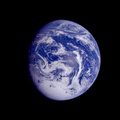
WIKIARCHIVES.SPACE
The Human Spaceflight Archive

Information
- Taken in
- Author
- NASA/JPL-Caltech
- Description
- The Magellan synthetic aperture radar (SAR) imaged this unique 'triplet crater,' or 'crater field' during orbits 418-421 on 21 September 1990. These craters are 14 kilometers, 11 kilometers, and 9 kilometers in diameter, respectively, and are centered at latitude -30.1 degrees south and longitude 345.5 degrees east. The Magellan Science Team has proposed the name Stein for this crater field after the American author, Gertrude Stein. This name has not yet been approved by the International Astronomical Union. The crater field was formed on highly fractured plains. The impacts generated a considerable amount of low viscosity 'flows' thought to consist largely of shock-melted target material along with fragmented debris from the crater. The three craters appear to have relatively steep walls based on the distortion in the image of the near and far walls of the craters in the Magellan radar look direction (from the left). The flow deposits from the three craters extend dominantly to the northeast (upper right).
- Created on
- Monday 29 January 1996
- Albums
- US SPACE PROGRAM / PROBES / VENUS / MAGELLAN / Mission Photos (Edited)
- Source link
- https://photojournal.jpl.nasa.gov
- Visits
- 20
- Rating score
- no rate
- Rate this photo
- License
- Public Domain
- Modified by WikiArchives
- No (original)
- Downloads
- 2
Powered by Piwigo























